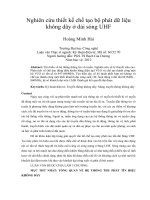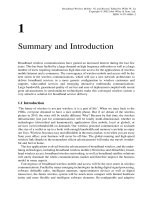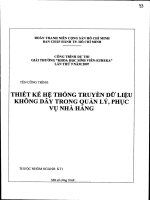Cẩm nang dữ liệu không dây P1 ppsx
Bạn đang xem bản rút gọn của tài liệu. Xem và tải ngay bản đầy đủ của tài liệu tại đây (123.43 KB, 9 trang )
I
GETTING STARTED
The Wireless Data Handbook, Fourth Edition. James F. DeRose
Copyright © 1999 John Wiley & Sons, Inc.
ISBNs: 0-471-31651-2 (Hardback); 0-471-22458-8 (Electronic)
1
A SHORT HISTORY OF
DATA RADIO
1.1 IN THE BEGINNING
In 1899, four years after Marconis first wireless telegraph, the British Navy converted
to data radio.
1
The Czars Navy quickly followed. By 1905 the Japanese had mastered
the key techniques and began to intercept messages from the Russian Vladivostok
fleet cruising secretly south of Tokyo Bay. Japans victorious Battle of Tsushima
followed.
Driven by continued military demands, wireless data technology leaped forward.
In 1914 the hapless Russians lost the Battle of Tannenburg because of German
intercepts of their land-based data radio communications and in 1917 the British
successfully employed radio telegraph in tanks at the Battle of Cambrai
2
; by 1918
these same units were adapted for aircraft.
In World War II both the United States and Germany communicated with and
controlled their widely scattered submarine fleets via data radio. During this
period H. C. A. Van Duuren
3
devised the technique still known as ARQ (Automatic
Repeat reQuest), one of those disarmingly simple ideas that seems so trivial in
retrospect. The idea was to ensure that a block of characters had been successfully
transmitted through the use of error
detection
. A detected error was followed by a
signal from the receiver asking the transmitter to repeat the block.
In the late 1950s wireless teletype units such as the CY2977LG were in use in
high-profile applications like the media pool aboard Air Force One. The
Semi-Automatic Ground Environment (SAGE) air defense system began testing
digitized radar information sent by data radio from airborne early warning aircraft.
The more complex messages were separated from the continuously repeating
X
and
Y
coordinates. A header identifying the radar address was added to the data. These
manageable segments were clear forerunners of what would later be called packets.
3
The Wireless Data Handbook, Fourth Edition. James F. DeRose
Copyright © 1999 John Wiley & Sons, Inc.
ISBNs: 0-471-31651-2 (Hardback); 0-471-22458-8 (Electronic)
These packets traveled from aircraft to ground station over dedicated radio circuits, as
in todays data-over-cellular.
In 1957 data radio modems reached speeds of 2000 bits per second (bps),
competitive with landlines of the time; by 1967 the General Dynamics
ANDEFT/SC-320 modem achieved 4800 bps.
4
In the early 1960s, building on the
seminal work of Shannon
5
and Hamming,
6
commercially practical error
correction
techniques were available. The stage was set for commercial exploitation of this
knowledge base.
1.2 PRIVATE NETWORKS LEAD THE WAY
In 1969 IBM began to develop a mobile data radio system for police departments.
Fueled by block grants from the Law Enforcement Assistance Administration
(LEAA), other vendors, including Kustom, Motorola, Sylvania/LTV, and Xerox,
offered alternatives. IBMs 2976 Mobile Terminal System was announced on May 12,
1972 (see Appendix B). A polled system, it nonetheless achieved good throughput for
its time with a combination of high (
∼
5400 bps) airlink transmission speeds, forward
error correction (which consumed half the bits), and ARQ.
The IBM system was a failure and was withdrawn in 1974. Competition fared little
better. The failure causes were many:
1. The termination of LEAA funding in 1973
2. The physical inadequacy of the devices: big, heavy, hot, noisy, and unreliable
3. A crushing lack of software support: for example, no dispatch applications
4. Unreadiness of the customers: no data bases or applications in place, inability
to cost justify the necessary development activity
But the dreamers persisted. In 1970 the successful University of Hawaiis ALOHA
system had established fundamental inbound contention techniques.
7
In 1975
Kleinrock and Tobagi
8
codified carrier sense multiple-access (CSMA) methods,
permitting greatly improved inbound performance.
Mobile Data International (MDI), founded in 1978 to provide a data radio system
for the Vancouver (B.C.) police, began to work with Federal Express in 1979. The
following year the first 12 commercial terminals employing CSMA were delivered to
the pioneering package delivery service. Very quickly the Federal Express device
count grew to 25,000 units, which attracted Motorolas eye. MDI was purchased, then
extinguished.
Meanwhile, IBMs Service Research organization had been privately piloting
briefcase-sized portable radio terminals, developing a business case for the
applications that would yield economic payoff. In November 1981 a contract was
signed with Motorola for the Digital Communication System (DCS). Nationwide
rollout began in April 1984 and was essentially complete two years later with the
installation of more than 1000 base stations.
4
A SHORT HISTORY OF DATA RADIO
DCS was a packet switched, pedestrian (low-target-velocity) oriented system that
broke much new technical ground. It used a single frequency on adjacent base stations,
with deliberately overlapping coverage patterns, to achieve better in-building
penetration. The end-user device was hand held, incorporating integrated radio
modems and internal dual diversity antennas for improved reception at walk speeds.
1.3 RISE OF PUBLIC PACKET SWITCHED NETWORKS
Of equal business importance, with the signing of the DCS contract, IBM and
Motorola agreed to work together on a shared network approach. The initial
opportunity estimates were enormous: 5 million subscribers were thought possible by
1987. Within IBM this period later came to be known as the first era of low hanging
fruit.
But during the period 19831985 there were serious business disagreements
between the two equally proud companies. IBM better understood the application
development barriers that would hinder rapid roll-out of this technology, having
struggled to place experimental customers on DCS via the then-extant IBM
Information Network. Motorola had a sounder grasp of the infrastructure changes
necessary to provide a high-availability system and had begun development of its
own, independent network. The proposal to build a public network resting on the
shoulders of DCS was rejected by the decision-making elements of both IBM and
Motorola for complex (and often emotional) internal business reasons.
After the collapse of the joint venture negotiations, Motorola unveiled its own
public packet switched network, the Digital Radio Network (DRN). This system used
DCS-class base stations but with area controllers sharply modified for both
performance and high availability. DRN began in Chicago in 1986 (Ericsson began
Mobitex in Sweden the same year). As IBM expected, making a market was an
extraordinarily difficult task. It was four years before DRN-Chicago had
∼
135
external users
9
; Los Angeles, rolling out second, took 20 months to achieve about the
same number; New York, 18 months behind Los Angeles, reached the 135 milestone
after one year. Clearly a positive learning curve existed, but the absolute pace was
exceedingly slow.
10
Five years after the negotiations failed, the plan was refurbished, principally by the
incorporation of Motorolas high-availability DRN switching centers. The venture
was agreed to by IBM, surprising since the airtime protocol remained proprietary to
Motorola. The Advanced Radio Data Information System (ARDIS) was announced in
January 1990. The system has been in continuous evolution ever since: new devices,
a new higher bit rate protocol, additional frequencies, roaming capability, and
extraordinary redundancy added to achieve high availability. The customer base has
grown slowly to
∼
40,000 at the end of 1994, reaching
∼
80,000 at the close of the third
quarter of 1998.
11
Building a market remains a continuous struggle.
On July 6, 1994, protracted disagreements between the two ARDIS partners were
resolved when Motorola bought out IBM. There were multiple reasons for this
transaction. Paramount was Motorolas desire, and willingness, to make the required
1.3 RISE OF PUBLIC PACKET SWITCHED NETWORKS
5
infrastructure investments necessary to drive horizontal markets
12
with their
Envoy/Marco devices. Envoy/Marco subsequently failed. At the close of 1997
Motorola, deciding that network management was not its forté and discouraged with
the general failure of horizontal market thrusts throughout the industry, sold ARDIS
to American Mobile Satellite Corporation (AMSC). AMSC was likely influenced by
the fact that ARDIS had won the United Parcel Service (UPS) contract, with devices
to be supplied by Motorola. Further, ARDIS had successfully partnered with AMSC
on combined terrestrial/satellite devices for trucks. The two companies were not
strangers.
In October 1990 RAM announced its public data service based upon Ericssons
newest Mobitex design. Initially plagued by a lack of nearly everythingadequate
base stations/coverage, hand-held modemsand a conviction that horizontal
applications were the path to success, RAMs failure to achieve an adequate
subscriber base was extraordinarily painful.
BellSouth Mobility became an essentially equal RAM partner in 1992 with the
investment of $300 million in urgently needed cash. Infrastructure deployment rates
jumped. Nationwide coverage was achieved in June 1993, albeit with a less extensive
coverage footprint than ARDIS.
By year-end 1994 RAM claimed to have
∼
27,000 paying subscribers
13
(most in
vertical markets) and several intriguing business relationships. As at ARDIS,
subscriber growth comes slowly: RAM claimed
∼
36,000 users at the close of the third
quarter of 1995
14
and probably reached
∼
70,000 at year-end 1997. BellSouth assumed
100% operational control of RAM on March 18, 1998,
15
renaming the company
BellSouth Wireless Data (BSWD).
1.4 CIRCUIT SWITCHED SKIMS THE EARLY CREAM
In 1983 the first data users improvised low-speed connections to their host computers
using ordinary modems over voice cellular circuits. Users treated these dial
connections much as they used ordinary landlines. They are now greatly helped by far
better modem capability, most
cellular ready
, and the formation of carrier
modem
pools
in most major metropolitan areas. Facsimile transmission alone, usually from a
portable computer to a wireline fax, has created thousands of casual public data radio
users.
In early 1992 UPS made a direct connection of its own leased facilities to cellular
mobile telephone switching offices (MTSOs), bypassing the public switched network
landlines. This resulted in very advantageous pricing, though there were time
connection limits. By February 1993 UPS had approximately 50,000
16
operational
units with this reduced tariff arrangement, significantly more subscribers than
DRN/ARDIS had achieved after seven years of effort. But the struggle to deal with
scores of cellular carrierseven though a consortium was created to smooth the
pathled UPS to begin the conversion to a nationwide packet switched solution.
ARDIS, beginning in late 1998.
6
A SHORT HISTORY OF DATA RADIO
Some carriers formed dedicated circuit switched data organizations similar to
Sprints national cellular data team formed during the Spring of 1993.
17
By mid-1994
most carriers had cellular modem pools in operation in at least some cities. The
ostensible reason for pool deployment is to avoid forcing users to convert the modem
facilities at their host sites. Another important reason is that dialing to a pool gives the
carriers the ability to distinguish between voice and data calls. Custom tariffs can
follow. An interesting example is that of Cellular One in Buffalo, NY, which charges
$0.15 per minute for data calls made during peak hours.
18
The advent of low-cost (<$300), fast-dial (under 20 seconds), high-speed (
∼
19,200
bps) modems and increasingly robust connections gave packet switched data a hearty
competitor for longer messages. This would ultimately be addressed by the carriers
with flat-rate packet pricing.
1.5 PACKET SWITCHED GATES CREAK OPEN
In 1991 many cellular carriers, both wireline and nonwireline, began to seriously
evaluate packet switched data with the expectation of securing a large new market. In
general, they tended to dismiss the hard ARDIS/BSWD experience as aberrant.
Several carriers issued request for proposals (RFPs). Motorola prepared responsible
proposals based on its high-speed radio data link access procedure (RD-LAP)
protocol. Ericsson held back, presumably because of business constraints evolving
from Mobitex and BellSouth.
The key issue for the carriers was whether Motorola would make RD-LAP an open
protocol. Motorola, awash in hubris, refused, thus snatching defeat from the jaws of
victory. The result was Cellular Digital Packet Data (CDPD) implementations by
multiple carriers and vendors.
CDPD was late to the market. By the third quarter of 1995 only 26 markets had
coverage equivalent to their voice cellular footprint
19
and AirTouch had already
closed its San Diego system
20
due to a lack of potential customers. By the close
of 1998 fifteen states had no CDPD presence, and key cities such as Atlanta and
Los Angeles remain uncovered. The carriers are Balkanized, with erratic roaming
agreements. Subscriber acceptance is low, probably
∼
15,000 total at year-end
1997.
There is a real possibility that the original nationwide vision may not unfold. Bell
Atlantic Mobilefirst to market with CDPDhas said
21
that one of the biggest
surprises it has encountered is the demand for more local and regional use versus the
demand for nationwide service. Sprint is blunter
21
: theres money to be made in
local and regional markets; customers can go elsewhere, such as (BSWD) or ARDIS.
for nationwide solutions. Ameritech announced that it will act as a nationwide
reseller for ARDIS and BSWD at the same time it continues to build out CDPD.
22
The practical result of this excess capacity is to drive airtime prices down. Perhaps, at
last, the long awaited, widespread adoption of wireless packet switched data is about
to be triggered.
1.5 PACKET SWITCHED GATES CREAK OPEN
7
1.6 NEW WIRELESS DATA ALTERNATIVES
In the satellite arena Qualcomms slow-bit-rate, data-only OmniTRACS system
rapidly began to show an increase in trucking company subscribers in mid-1993. By
the first quarter of 1998 OmniTRACS had shipped 230,000 units worldwide and was
a clear success. This accomplishment attracted competitors, most of whom also
offered voice. AMSC and a terrestrial alternative, HighwayMaster, picked off a great
many potential OmniTRACS subscribers during the period 19971998.
None of these solutions could attack the trailer opportunity. Qualcomm is poised
to attack that problem with the use of Aeris Microburst, a terrestrial cellular control
channel approach. The first proponent of the use of the cellular control channel for
telemetry purposes was BellSouth, with its Cellemetry system. These control channel
systems are ideally suited to infrequent, very small information content messages.
Other data-only alternatives began to appear in 1994. The first operational was
Metricoms very low priced, high-bit-rate, regional system Ricochet. While confined
to a limited number of cities and airports, Ricochet offers high bit rates, which will
grow even higher in 1999, suitable for Internet access.
Testing also commenced on Mobile Telecommunications Technologies (MTels)
narrow-band personal communication services (PCS) system, then called Destineer.
In September 1995 MTels subsidiary, SkyTel, began its initial two-way pager service
with narrow-band devices built by Motorola. This was a prelude to a series of similar
offerings. BSWD, followed by ARDIS, began to introduce competitive two-way
paging with devices built by Research-In-Motion (RIM). To prepare for this
undertaking, BSWD has invested an enormous amount of capital in extensive network
upgrades. At the close of 1998, major success has eluded all three participants. There
was also activity in the primarily voice-oriented special data services. NexTel, focused
on eliminating problems with its new digital voice dispatch service, was able to
introduce a limited-message-length, circuit switched data service at the close of 1994.
More than 60,000 data capable voice instruments were in operation by the third
quarter of 1995.
23
Nextel does not give data much emphasis, seemingly poised for a
new packet alternative in 1999 or beyond. GeoTek, with a different digital technology,
introduced its voice/data system in 1996 but was bankrupt by October 1998.
In the private market Federal Express began moving to a new generation of devices
in 1998, with 40,000 devices to be deployed by 1999. The radio modems and
infrastructure are supplied by subsidiaries of AMP. The design is such that the devices
could be used on a public packet switched system if that mode of operation makes
more business sense in the future.
1.7 SUMMARY
Over the nine decades commencing in 1899 wireless data evolved from low-bit-rate
military systems into high-cost private systems developed for quasi-military
organizations such as police departments. In just the past decade a remarkable
8
A SHORT HISTORY OF DATA RADIO
convergence of technologies permitted reasonably priced, physically small,
near-wireline-speed, public wireless systems to become a reality.
Key technology drivers include the nearly simultaneous occurrence of the voice
cellular systems, with their now unthinkably low priced hand-held phones, and the fast
growing laptop computer. The 1985 perception of ruinous spectrum constraints has
yielded to a variety of mostly digital technical solutions, including inexpensive, tiny,
reasonably fast modems. Continued application development, along with a once
unimaginable growth in complex data bases, has begun to create a desire for work to
be accomplished
anytime/anywhere
.
Adoption results to date have been disappointing to all pioneers, but the struggle
continues. Ever more competitors enter the potential marketplace, with the inevitable
lowering of network usage costs. Many pioneers suffer, even perish, but the user is
likely to have a rich choice of alternatives in the future.
REFERENCES
1. G. W. Brock,
The Telecommunications Industry
, p. 162.
2. A. Livesy,
Great Battles of World War I
, pp. 31, 128.
3. P. E. Green, Jr., Computer Communications: Milestones,
IEEE Communications
Magazine,
Vol. 22, No. 5, 1984, p. 55.
4. G. C. Porter, Error Distribution and Diversity Performance of a Frequency-Differential
PSK HF Modem,
IEEE Transactions on Communications Technology
, Vol. COM-16,
1968, pp. 567575.
5. C. E. Shannon, Mathematical Theory of Communications,
Bell System Technical
Journal
, JulyOct. 1948.
6. R. W. Hamming, Error Detection and Error Correcting Codes,
Bell System Technical
Journal
, Apr. 1950.
7. N. Abramson, The ALOHA SystemAnother Alternative for Computer
Communications,
AFIPS Conference Proceedings
, Vol. 37, AFIPS Press, Montvale, NJ,
1970, pp. 281285.
8. L. Kleinrock and F. A. Tobagi, Packet Switching in Radio Channels. Part I: Carrier
Sense Multiple Access Modes and Their Throughput-Delay Characteristics,
IEEE
Transactions on Communications
, Vol. COM-23, No. 12, 1975, pp. 14001416.
9. From FCC Loading Records.
10. It is worth noting that Mobitex Sweden has fared worse. After eight years the total
subscriber count was
∼
8000. Source: Ovum, Ltd.,
Communications Week International
,
6-28-93.
11. Derived from AMSC 3Q98 report, No. 98-26, 10-29-98.
12. R. Growney, ARDIS Chicago Sofitel Conference, July 26 1994.
13. W. Lenahan, RAM President and CEO,
Land Mobile Radio News
, 1-27-94.
14. W. Lenahan, RAM President and CEO, Analyst & Media Conference, Newark Radisson,
10-31-95.
15. />16. P. Heller, UPS Division Manager for Mobile Networks,
Mobile Data Report
, 2-15-93.
REFERENCES
9
17.
Mobile Data Report
, 6-7-93.
18. W. Sanders, Division Manager for Wireless Data, Buffalo Telephone, as reported in
Communications Week
, 7-25-94.
19. CDPD Forum Quarterly Report,
Wireless Data News
, 10-18-95.
20. U. Kohli, AirTouch Marketing VP,
Mobile Data Report
, 6-5-95.
21.
Advanced Wireless Communications
, 6-7-95.
22.
Communications Today
, 10-30-95.
23.
PCIA Bulletin
, 10-27-95.
10
A SHORT HISTORY OF DATA RADIO









